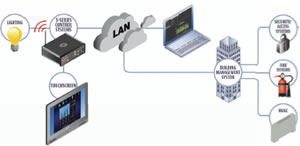Teaching Campus Buildings to Talk
Integrated security and building systems are making buildings smart enough to automate tasks and even report in.
- By Michael Fickes
- 11/01/13

PHOTO COURTESY OF COLUMBIA UNIVERSITY OFFICE OF UNDERGRADUATE ADMISSIONS
If only buildings could talk. They could tell you where they hurt. Hey, my compressor feels funny. Help me, help me; someone is messing with my locks. I don’t feel any electricity flowing through my wires.
In fact, campus security and building systems can tie together in a way that enables them to report and initiate solutions to security problems as well as preventive maintenance and repair needs.
This kind of functionality has been trumpeted for at least 10 years now. Ten years ago, however, actually integrating building systems to do this was a massively expensive, complicated and time-consuming task. Many who tried it regretted the effort and eventually gave up.
Today, the technology exists to carry through on integration efforts and gain the benefits of automated building systems.
What Makes Integration Easier Today?
“Over the past 10 years, communications technology has progressed with systems like BACnet and internet protocol,” says Gwenn McDaniel, sales director, education, with Milwaukee-based Johnson Controls.
BACnet, which stands for building automation and control network, is a technology that enables diverse building systems to talk to each other. These systems include heating, ventilation and air-conditioning control, lighting control, access control, security, elevator, maintenance and fire detection systems. Observers liken BACnet to Internet Protocol, or IP, the technology that enables diverse devices to communicate with each other over the Internet.
In addition, software tools such as application programming interfaces (APIs) and Software Development Kits (SDKs) help to different kinds of software and hardware to communicate with each other.
An API is a tool that programmers use to enable one software application to communicate with another. An SDK contains reusable software code that reduces the amount of code that developers must write when tying systems together, thereby speeding the work.
Then there is PSIM, or physical security information management, a software category that can integrate various security applications into a single user interface.
BACnet, APIs, SDKs, open protocols, PSIM and other technological advances have combined to make integration and automation easier to carry out. “In addition, various tools have been standardized for internet protocol or IP use,” notes McDaniel. “IP cameras connect over the network, access control systems communicate over IP networks. That trend has helped make integration easier.”
Another positive development has been the consolidation of networked systems. “In 1990, many of our customers ran separate networks for building automation, fire, security and business systems in in the case of K–12 schools’ educational systems,” McDaniel says. “Today, everyone understands that multiple networks are a waste of money, and now everyone uses the same communication highway.”
McDaniel also points to policy changes by local fire marshals and the National Fire Protection Association (NFPA).
“Ten years ago, building automation technology was ahead of fire protection policies,” she says. “We would sell the concept to a customer, but then we had to talk to the Authority Having Jurisdiction, the AHJ, about having the fire-life safety system talk to a piece of software to activate the security system. NFPA wasn’t comfortable that software was reliable enough. As a result, the AHJs wouldn’t approve these systems.
“Thanks to the many technical developments made over the past decade, great progress has been made in enabling technical systems to talk to each other and initiate actions. As a result, the NFPA and local governments have accepted software communications between fire and security systems.”
What Can Integrated Building and Security Systems Do?
When someone cards into a building during off-hours, the security system can talk to the building systems, which will turn on the lights and the HVAC system in that individual’s office or wing of the building.
The access control system might also swing a surveillance camera toward the door as the individual enters and send video to the public safety center, where a security officer will check to make sure that the person that entered the building is also the person that owns the card.
PSIM software can analyze data from access control, video and other security technologies and draw conclusions about security events. The software can be programmed to direct the security response.
For instance, the access control system may detect a break-in at a residence hall door. The PSIM software can be set to turn a camera to look at the door and send an alert, including video, to patrolling security officers.
Automating Beyond Security
Suppose a college rents the campus performing arts center out to community theaters. Someone must go to the theater, unlock the doors, and turn on the lights and the HVAC system. “With an automated campus, the person that schedules the event simply emails the person managing the building automation systems in the facilities department,” McDaniel says.
“Automation can save labor in other ways, too,” she continues. “You can use a continuous diagnostic system to collect data from all of the components in all of the building and security systems and send it to the cloud. There, a company analyzes the data and reports back on components that may be getting ready to fail, are using too much power or operating inefficiently in some other way.”
Replacing a component before it fails and perhaps damages the larger system can save a lot of labor and expense.

ILLUSTRATION COURTESY OF CRESTRON ELECTRONICS, INC.
WE’RE ALL CONNECTED. BACnet, or building automation and control network systems, can enable the connection of all the technology and devices in a building or on a campus onto a single platform so they work together seamlessly and intelligently. Anything and everything connected to a control system can be monitored, managed and controlled — anytime, anywhere — from a touch screen, laptop or smart device. Integrated control of lighting, shades, HVAC, AV, BMS, security, voice and data, and other connected systems can be faster, simpler and more efficient. Built-in BACnet/IP support enables seamless integration with existing building management systems. All systems run independently and communicate with each other on the same platform, creating a truly smart building.
Another task that automation can handle without taking anyone’s time is compliance reporting. McDaniel uses an animal laboratory as an example. Complying with the data reporting regulations for such facilities might involve recording and date stamping the faculty, students and staff that card in and out. Regulations might also require data on the environmental conditions, such as humidity and temperature. Automated building and security systems can pull this information and format it into reports at regular intervals.
Pre-Planning
Finally, McDaniel says that planning is key to successful building and security automation.
She urges that preliminary meetings include facilities, maintenance, security, IT, faculty from the department or administrators that will use the building — anyone that might have an automated need.
“You need to discuss the pieces of data that need to be exchanged within the system,” she says. “Suppose I’m a student going to a chemistry lab after hours. When I card in the lights, air conditioning or heat come on in my space. What about the fume hood? That should come on, too, and you might not think about that if you don’t talk to the chemistry professor.”
Pre-planning doesn’t mean that you must install all of the automated systems you discuss when you build new or renovate. It means that you have made provisions with the design and construction of the building’s infrastructure that will enable you to automate the building as economically as possible when budget permits.
This article originally appeared in the College Planning & Management November 2013 issue of Spaces4Learning.